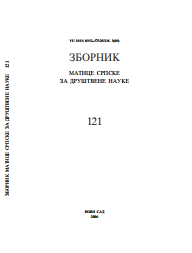ЖЕНЕ И МУШКАРЦИ У БЕОГРАДУ (КРОЗ СТАТИСТИКУ)
WOMEN AND MEN IN BELGRADE (THROUGH STATISTICS)
Author(s): Radmila VićentijevićSubject(s): Gender Studies, Demography and human biology
Published by: Матица српска
Keywords: gender structure; demography; Belgrade;
Summary/Abstract: As in other East-European countries, in Serbia and Montenegro, the equality of sexes is built in a system as a part of ideology related to the progres in the position of women in a society. The field of education is specially emphasized. According to the census 1991 and 2002, in Serbia and Montenegro there lived 50, 39%, that is 51, 37% of women in the total number of population. In Belgrade that percentage was 51, 60%, that is 52, 55%. This data tells about a large participation of women in the population. In the field of working legislature, women are equal as men. But formal equality doesn’t give always a real equality. For active women population in Belgrade, the characteristic is a really high economic activity. The percentage of maintained women in 2002 was 61, 80% in The Republic of Serbia, which is 58, 55% in Belgrade. In a structure of maintained women, according to their contribution, the first place is ocupied pupils and students (over 40%), then with one third housewives, 20% children and 1% persons upable to work. We can notice a reduction in the contribution of housewives in a number of maintained women population. According to the education level, the largest number of employed women is with secondary education 38, 05%. With high and higher education 34, 28%, women are employed which makes 72, 33% of the total number of employed women. This data tells as that there is an extremely high educational level of employed women in legal entities. Women participation in political life, in the work of political parties and diplomatic branches grows slowly. A number of women-board members at the latest elections 2004 in the city assembly of Belgrade was 31, 0%, in Niš 23,0% in Novi Sad 28,0% from the total number of board members. This percentage is still unsatisfactory, but this shows a better involvement and participation of women in the political scene. According to marriages, the percentage of bridegrooms in Belgrade in 1997 was 62,4%, in 1981 it was 63,0%, in 1991 it was 60.3% and in 2002 it was 53,4%. The percentage of single women grew from 20,4% in 1971 to 24,36% in 2002. Higher educational structure, higher activity rate and women employment, caused their better economic status, but at the same time this reflected ‘negatively’ in family size, and through it in a total population in the Republic and the town.
Journal: Зборник Матице српске за друштвене науке
- Issue Year: 2006
- Issue No: 121
- Page Range: 383-390
- Page Count: 8
- Language: Serbian

